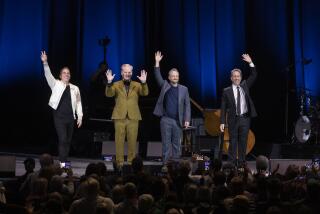‘Hamlet’ goes high tech at the REDCAT
Any director of “Hamlet” must decide what kind of ghost will haunt the melancholy prince. Will it be a sheet-draped actor rattling chains, an apparition of special effects or a disembodied voice suggesting Freudian freakiness?
In the Wooster Group’s radical, and often scenically mesmerizing, video-spliced deconstruction of “Hamlet,” which opened Wednesday at REDCAT under the direction of company leader Elizabeth LeCompte, the spectral presence at the heart of the show isn’t Hamlet’s murdered father. It’s a legendary performer who conquered the role on Broadway in 1964. A film of Richard Burton’s “Hamlet,” originally staged by John Gielgud, serves as a kind of flickering canvas for the group’s lovingly winking re-creation.
The venerable New York-based performance collective, one of the most enduring and fertile entities of the American avant-garde, has finally gotten around to the Bard. The group’s signature multimedia method is to pair canonical texts by playwrights such as Thornton Wilder, Gertrude Stein and Racine with entertainment curiosities such as blackface vaudeville, soft-core porn and amateur badminton to create compositions that are one part critical commentary, two parts dazzling postmodern craft. But that isn’t exactly the strategy here.
This “Hamlet” is as straightforward as the company’s technologically thrilling production of Eugene O’Neill’s “The Hairy Ape,” the last word (for me, anyway) on that strange and seemingly unproduceable play. Of course, straightforward for this experimental crew still means roller coaster curves, and so Shakespeare lovers expecting the players to let the famous speeches flow trippingly from their tongues while holding the mirror up to nature should think again. This is a 21st century karaoke version of a celebrated 20th century “Hamlet,” filtered through the Wooster Group’s inimitable (don’t try this at home!) sensibility.
The program says “the Burton production was recorded in live performance from 17 camera angles and edited into a film that was shown for only two days in 2,000 movie houses across the U.S.” The hope of bringing a high-brow Broadway bonanza to thousands of viewers in different parts of the country was “trumpeted as a new form called ‘Theatrofilm,’ made possible through ‘the miracle of Electronovision.’ ”
Not that we’re given much direct contact with the film, which, though available on DVD, is presented as if it had been snatched from the jaws of oblivion. Scenes abruptly dissolve into blizzards of static, actors fade into celluloid black, and the sound pops and thins so that the voices of the original cast seem to be teasing us with their ephemerality.
Meanwhile, the actors onstage, performing in front of a scrim onto which the movie is projected, flesh out what is incompletely screened for us. Rolling around on metallic furniture to reflect the shifting camera positions, they can also be seen on smaller video monitors, the ones that aren’t showing Burton’s “Hamlet” or tidbits from Kenneth Branagh’s.
Scott Shepherd, one of the company’s latter-day virtuosos, has the tricky task of trying to match Burton, whose performance New York Times critic Howard Taubman extolled for its “electrical power and sweeping virility.” The handsome visage looming before us in black and white is impossible to compete with, and Shepherd is at his best when he pays homage through imitation of Burton’s compelling vocal cadences.
Shepherd doesn’t try to duplicate Burton’s emotional heft. (One look at the Welsh actor’s heavy-lidded eyes during the “To be or not to be” soliloquy tells you all you need to know about what you’re not getting from the simulacrum.) That’s to be expected given the Wooster Group’s style of performing in quotation marks.
But one would have liked Shepherd to inject more of his customary deadpan humor, the way Kate Valk, wearing the most waggishly delightful wigs, portrays Gertrude and Ophelia in a manner that slyly pokes fun at gender stereotypes and acting traditions. It’s hard not to wonder whether she, out of everyone in the precisely synchronized troupe, could have made something livelier out of this Hamlet Xerox.
The video, which has been hypnotically designed by Reid Farrington, with Andrew Schneider, ultimately turns this Shakespearean experience into something more visual than textual. Staid English teachers should probably stay away. This is a “Hamlet” not just for intrepid followers of cutting edge performance but also for painters, filmmakers, choreographers and installation artists seeking to break into new modes of expression. It may not represent the Wooster Group aesthetic at its most theatrically satisfying, but it makes for necessary viewing for anyone following the path of this trailblazing ensemble.
--
--
‘Hamlet’
Where: REDCAT (Roy and Edna Disney/CalArts Theater), 631 W. 2nd St., L.A.
When: 8:30 p.m. Tue.-Sat.; 7 p.m. Sun.; 3 p.m. Feb. 10
Ends: Feb. 10
Price: $25 to $55
Contact: (213) 237-2800; www.redcat.org
Time: 2 hours, 45 minutes
More to Read
The biggest entertainment stories
Get our big stories about Hollywood, film, television, music, arts, culture and more right in your inbox as soon as they publish.
You may occasionally receive promotional content from the Los Angeles Times.











